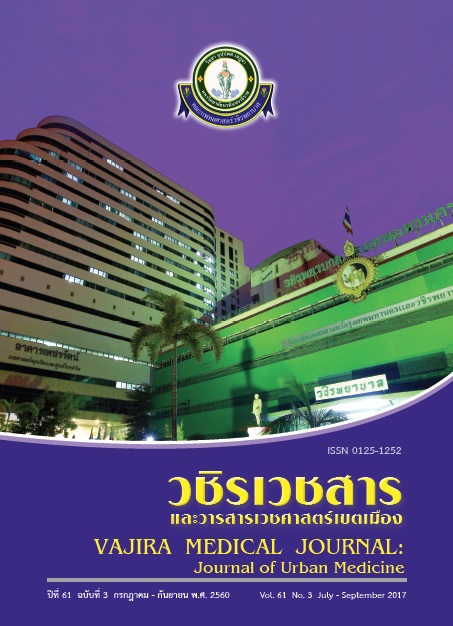Prevalence of Steroid Non-Responsive Immune Thrombocytopenia Patient in Vajira Hospital
Main Article Content
Abstract
Objective: Immune thrombocytopenia (ITP) is frequently found in general practice. The first-line therapy is corticosteroid; however, some ITP patients do not response to corticosteroid. These patients are at risk of life-threatening bleeding during thrombocytopenic period. The epidemiologic and clinical risk predictors of steroid non-responsive ITP are not completely known. We aimed to study the epidemiology and clinical predictors of steroid non-responsive adult ITP patients.
Methods: This was a retrospective descriptive study in patients aged 15 years and older who had been diagnosed as ITP at Hematology Clinic, Vajira Hospital between 1st January 2013 and 31st December 2015. Baseline characteristics and clinical predictors of steroid non-responsive ITP were analyzed.
Results: Of 80 adult patients with ITP, 27 were steroid non-responsive. (33.8%). Fifty-seven patients were female (71.3%). Mean age was 57 years. Time from diagnosis to treatment was mainly less than 12 months (93.8%). Majority of these patients did not have underlying disease nor positive serology (i.e. HBsAg, Anti-HCV, Anti-HIV and ANA). Platelet counts at presentation were mainly less than 20,000 cell/mm3 (58.8%). The analysis of binary logistic regression, found none of clinical factors was statistically significantly correlated with steroid non-responsive ITP.
Conclusion: Prevalence of steroid non-responsive was 33.8% of all ITP patients in Vajira hospital. None of clinical factors was statistically significantly correlated with steroid non-responsive.
Article Details
References
2. Abrahamson PE, Hall SA, Feudjo-Tepie M, Mitrani-Gold FS, Logie J. The incidence of idiopathic thrombocytopenic purpura among adults: a population-based study and literature review. Eur J Haematol. 2009;83:83-9.
3. Neylon AJ, Saunders PWG, Howard MR, Proctor SJ, Taylor PRA. Clinically significant newly presenting autoimmune thrombocytopenic purpura in adults: a prospective study of a population-based cohort of 245 patients. Br J Haematol. 2003;122:966-74.
4. Guidelines for the investigation and management of idiopathic thrombocytopenic purpura in adults, children and in pregnancy. Br J Haematol. 2003;120:574-96.
5. Han JJ, Baek SK, Lee JJ, Kim SY, Cho KS, Yoon HJ. Long-term outcomes of a 5-year follow up of patients with immune thrombocytopenic purpura after splenectomy. Korean J Hematol. 2010;45:197-204.
6. George JN, Woolf SH, Raskob GE, Wasser JS, Aledort LM, Ballem PJ, et al. Idiopathic thrombocytopenic purpura: a practice guideline developed by explicit methods for the American Society of Hematology. Blood. 1996;88:3-40.
7. Teawtrakul N, Sirijerachai C, Chansung K. Idiopathic Thrombocytopenic Purpura in Adults at Srinagarind Hospital: 9 Years Review. Srinagarind Med J. 2012:27(1):43-8.
8. Segal JB, Powe NR. Prevalence of immune thrombocytopenia: analyses of administrative data. J Thromb Haemost. 2006;4:2377-83.
9. Fogarty PF. Chronic immune thrombocytopenia in adults: epidemiology and clinical presentation. Hematol Oncol Clin North Am. 2009; 23: 1213-21.
10. Syed NN, Adil SN, Sajid R, Usman M, Moiz B, Kakepoto GN, et al. Chronic ITP: analysis of various factors at presentation which predict failure to first line treatment and their response to second line therapy. JPMA. 2007;57:126-129.
11. Wanachiwanawin W, Visudhiphan S, Pinankijagum A, Vatanavicharn S. Therapy of chronic idiopathic thrombocytopenic purpura in adults: experiences from Thailand. Southeast Asian J Trop Med Public Health. 1993; 24 Suppl 1:71-5.
12. Wanachiwanawin W, Visudhiphan S, Piankijagum A, Vatanavicharn S. Serious complications following treatment of chronic idiopathic thrombocytopenic purpura. Postgrad Med J. 1988; 64:426-30.
13. Rodeghiero F, Stasi R, Gernsheimer T, Michel M, Provan D, Arnold DM, et al. Standardization of terminology, definitions and outcome criteria in immune thrombocytopenic purpura of adults and children: report from an international working group. Blood. 2009; 113:2386-93.
14. Rodeghiero F, Besalduch J, Michel M, Provan D, Grotzinger K, Thompson G. Treatment practices in adults with chronic immune thrombocytopenia-a European perspective. Eur J Haematol. 2010; 84:160-8.
15. Schoonen WM, Kucera G, Coalson J, Li L, Rutstein M, Mowat F, et al. Epidemiology of immune thrombocytopenic purpura in General Practice Research Database. Br J Haematol. 2009; 145:235-44
16. Frederiksen H, Schmidt K. The incidence of idiopathic thrombocytopenic purpura in adults increases with age. Blood. 1999;94:909-13.
17. Stasi R, Stipa E, Masi M, Cecconi M, Scimò MT, Oliva F, et al. Long-term observation of 208 adults with chronic idiopathic thrombocytopenic purpura. Am J Med. 1995;98:436-42.

